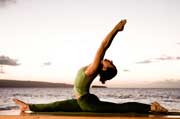Yoga is the most important inheritance of yesterday, the essential need of today and the culture of tomorrow. It is the science of right living. 

In recent years Yoga has migrated substantially from a limited Indian art to an international science of global significance and from a path of individual ‘sadhana’ to a movement of social transformation. Yoga is essentially spiritual but its physical values also cannot be ignored. Yoga therapists make use of the physical values of Yoga for healing of diseases. Yoga therapy mainly includes asanas (different yogic postures), Pranayama (breathing techniques), meditation and shatkarma. These are quite helpful in treating stress related diseases and lifestyle diseases like diabetes, hypertension etc.
1. Role of Asanas
2. Role of Pranayama
3. Role of Meditation
4. Shatkarma
ROLE OF ASANAS
Asanas play an important role in healing diseases of body and mind. The gross form of mind is body and subtle form of body is mind. The practice of asanas inte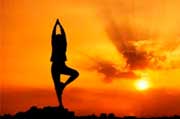 grates and harmonizes the two. Every mental knot has a corresponding muscular knot and vice versa. Practice of asanas releases these knots.
grates and harmonizes the two. Every mental knot has a corresponding muscular knot and vice versa. Practice of asanas releases these knots.
Practice of asanas reduces the blood le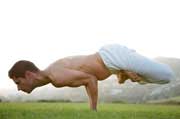 vel of catecholamines and acetylcholine, the neurotransmitters responsible for stressful conditions, thus helping to reduce stressful conditions. Yogic postures appear to exert neuro-physiological stability, as is evident from the lowered blood level of cholinesterase and catechola- mines. The improved physiology and mental makeup of practitioners of yogic postures make them less liable to mental fatigue. Though a lot of asanas are possible only a few are of help in the area of therapy.
vel of catecholamines and acetylcholine, the neurotransmitters responsible for stressful conditions, thus helping to reduce stressful conditions. Yogic postures appear to exert neuro-physiological stability, as is evident from the lowered blood level of cholinesterase and catechola- mines. The improved physiology and mental makeup of practitioners of yogic postures make them less liable to mental fatigue. Though a lot of asanas are possible only a few are of help in the area of therapy.
ROLE OF PRANAYAMA
Pranayama or Yogic breathing constitutes volitional control of breathing. It is particularly of he lp in mental stress related diseases and diseases of the respiratory system. Pranayama increases the vital capacity of the lungs and its oxygen trapping capacity is also enhanced. This results in the overall increase of efficiency of the lungs, which helps fighting breathing disorders like bronchial asthma. Pranayama reflexly stimulate cerebral circulation and improves the function of brain. As mind is passively attached to the pranayamic process, it becomes calm, quiet and tranquil because of slow, smooth and prolonged breathing during pranayama.
lp in mental stress related diseases and diseases of the respiratory system. Pranayama increases the vital capacity of the lungs and its oxygen trapping capacity is also enhanced. This results in the overall increase of efficiency of the lungs, which helps fighting breathing disorders like bronchial asthma. Pranayama reflexly stimulate cerebral circulation and improves the function of brain. As mind is passively attached to the pranayamic process, it becomes calm, quiet and tranquil because of slow, smooth and prolonged breathing during pranayama.
ROLE OF MEDITATION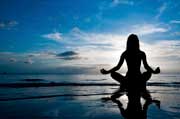
It is one of the commonest experiences that when we are driven away by our anger, we need to become silent for sometime in order to get rid of it. Meditation as a therapy is just a reshape of our above experience. Meditation is helpful in stress related mental diseases and improves the quality of living. Meditation reduces mental stress by giving maximum rest to the brain. Acceleratio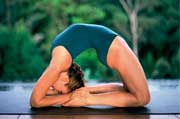 n of heart rate, rise in Blood Pressure(B.P), increase in the muscle tone and resultant increase in Basal Metabolic Rate (BMR) are noted in mental stress. Lowering of BMR and reduction in oxygen consumption by meditation leads to marked mental relaxation, lowering of B.P, muscular relaxation and improved cardiac function. More over constant and sincere practice of meditation lowers the plasma cortisol levels, which gives relief from mental stress.
n of heart rate, rise in Blood Pressure(B.P), increase in the muscle tone and resultant increase in Basal Metabolic Rate (BMR) are noted in mental stress. Lowering of BMR and reduction in oxygen consumption by meditation leads to marked mental relaxation, lowering of B.P, muscular relaxation and improved cardiac function. More over constant and sincere practice of meditation lowers the plasma cortisol levels, which gives relief from mental stress.
SHATKARMA
The human bod y consists of two major channels of Pranic flow known as Ida and Pingala, representing right and left side of the body respectively. Shatkarma is the group of six Yogic purification practices, which restores and maintains the delicate harmony between these two thereby attaining physical and mental purification and balance. They are
y consists of two major channels of Pranic flow known as Ida and Pingala, representing right and left side of the body respectively. Shatkarma is the group of six Yogic purification practices, which restores and maintains the delicate harmony between these two thereby attaining physical and mental purification and balance. They are
1. Neti: – A process of cleansing and purifying the nasal passage.
2. Dhauti: – A series of cleansing techniques that clean the entire alimentary canal from the mouth to anus.
3. Nauli: – A method of massaging and strengthening the abdominal organs.
4. Basti: – Techniques for washing and toning the large intestinal.
5. Kapalbhati: – A breathing technique for purifying the frontal region of brain.
6. Trataka: – The practice of intense gazing at one point or object which develops the power of concentration.
They are also used to balance the three doshas (humours) in the body: – Vata, Pitta and Kapha. These powerful techniques should always be done under proper guidance.
In Ayurdwar we provide result oriented Yoga therapy by Yoga experts.